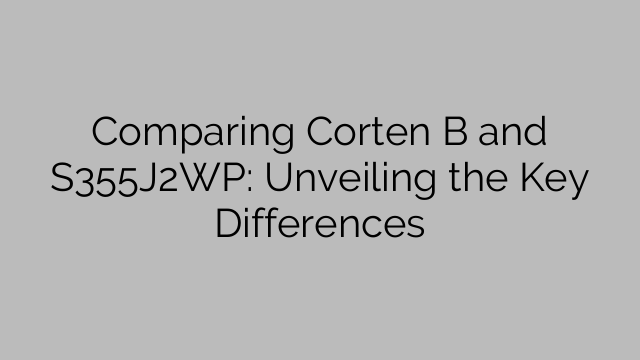When it comes to choosing the right material for various construction projects, it is essential to have a clear understanding of their properties, strengths, and weaknesses. In the world of steel alloys, Corten B and S355J2WP are two widely used materials known for their excellent weather resistance and durability. However, it is crucial to unveil the key differences between these two materials to make an informed decision.
Corten B, also known as weathering steel, is a type of steel alloy that forms a protective layer of rust when exposed to the elements. This unique characteristic gives it a distinct appearance, often described as “rusty” or “weathered.” The protective rust layer acts as a barrier, preventing further corrosion and deterioration of the material. Its aesthetic appeal has made Corten B a popular choice for architectural structures and outdoor sculptures.
On the other hand, S355J2WP is a structural steel grade specifically designed for use in harsh weather conditions. It is part of the EN 10025-5 standard, which specifies the technical delivery conditions for structural steels with improved atmospheric corrosion resistance. S355J2WP offers increased resistance to atmospheric corrosion compared to regular structural steels, making it suitable for outdoor applications, such as bridges, façades, and container frames.
When comparing Corten B and S355J2WP, one significant difference is their chemical composition. Corten B primarily consists of iron, copper, chromium, and nickel, with small amounts of phosphorus and silicon. This composition gives Corten B its unique weathering properties, allowing it to develop a protective rust layer. In contrast, S355J2WP contains primarily iron, along with traces of copper, phosphorus, chromium, nickel, and silicon. The different chemical compositions contribute to their varying degrees of atmospheric corrosion resistance.
Another important factor to consider is their mechanical properties. Corten B has a minimum yield strength of 355 MPa and a tensile strength of 470-630 MPa, providing excellent structural integrity. Its high-strength characteristics are ideal for load-bearing structures and heavy-duty applications. On the other hand, S355J2WP has a minimum yield strength of 355 MPa, similar to Corten B, but its tensile strength is slightly lower, ranging from 510-680 MPa. However, S355J2WP compensates for this by offering superior atmospheric corrosion resistance compared to Corten B.
Furthermore, Corten B and S355J2WP differ in terms of their applications and availability. Corten B is well-suited for outdoor architectural features, such as building facades, bridges, and sculptures, where its unique appearance adds an artistic touch. It is widely available and used in various construction projects across the globe. S355J2WP, being a more specialized grade, is typically used in structural applications exposed to harsh weather conditions, including bridges, containers, and railway wagons. However, it may be slightly less readily available compared to Corten B due to its specific purpose.
In conclusion, while both Corten B and S355J2WP offer excellent weather resistance and durability, it is important to understand their key differences. Corten B is known for its distinct appearance and wide availability, making it suitable for architectural and artistic applications. Meanwhile, S355J2WP provides superior atmospheric corrosion resistance and is commonly used in structural projects exposed to harsh weather conditions. By considering these differences, construction professionals and designers can make an informed decision about which material to choose for their specific needs.

